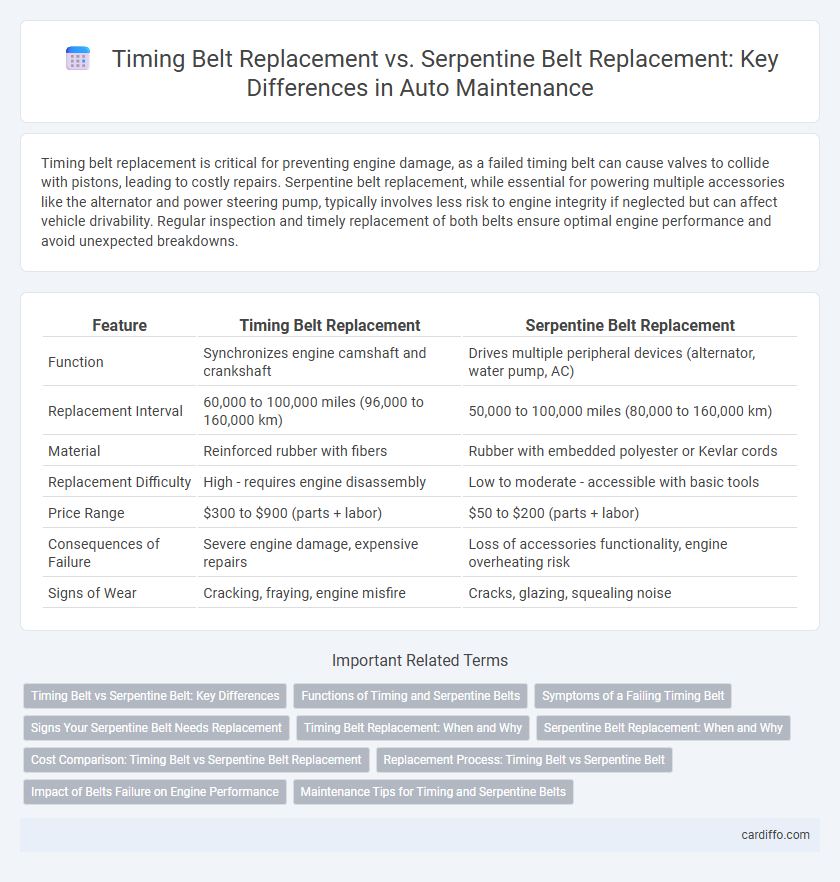Timing belt replacement is critical for preventing engine damage, as a failed timing belt can cause valves to collide with pistons, leading to costly repairs. Serpentine belt replacement, while essential for powering multiple accessories like the alternator and power steering pump, typically involves less risk to engine integrity if neglected but can affect vehicle drivability. Regular inspection and timely replacement of both belts ensure optimal engine performance and avoid unexpected breakdowns.
Table of Comparison
| Feature | Timing Belt Replacement | Serpentine Belt Replacement |
|---|---|---|
| Function | Synchronizes engine camshaft and crankshaft | Drives multiple peripheral devices (alternator, water pump, AC) |
| Replacement Interval | 60,000 to 100,000 miles (96,000 to 160,000 km) | 50,000 to 100,000 miles (80,000 to 160,000 km) |
| Material | Reinforced rubber with fibers | Rubber with embedded polyester or Kevlar cords |
| Replacement Difficulty | High - requires engine disassembly | Low to moderate - accessible with basic tools |
| Price Range | $300 to $900 (parts + labor) | $50 to $200 (parts + labor) |
| Consequences of Failure | Severe engine damage, expensive repairs | Loss of accessories functionality, engine overheating risk |
| Signs of Wear | Cracking, fraying, engine misfire | Cracks, glazing, squealing noise |
Timing Belt vs Serpentine Belt: Key Differences
Timing belt replacement typically occurs every 60,000 to 100,000 miles and is critical to prevent engine damage, as it synchronizes the camshaft and crankshaft. Serpentine belt replacement generally spans 50,000 to 70,000 miles, driving multiple accessories like the alternator and power steering pump. Unlike the serpentine belt's external role, the timing belt ensures precise internal engine timing, making its failure more catastrophic.
Functions of Timing and Serpentine Belts
Timing belts synchronize the rotation of the crankshaft and camshaft, ensuring precise valve timing for engine performance and preventing engine damage. Serpentine belts drive multiple peripheral devices such as the alternator, power steering pump, water pump, and air conditioning compressor, maintaining vehicle functionality. Replacing timing belts is critical to avoid engine failure, while serpentine belts require replacement to sustain accessory operation.
Symptoms of a Failing Timing Belt
A failing timing belt often produces symptoms such as engine misfires, ticking noises from the engine, and difficulty starting the vehicle, all of which indicate the necessity for immediate replacement to prevent severe engine damage. Unlike the serpentine belt, which drives accessory components like the alternator and power steering pump, the timing belt synchronizes the camshaft and crankshaft movements, making its failure critical to engine operation. Ignoring early signs of timing belt wear can lead to catastrophic engine failure, emphasizing the importance of timely maintenance based on manufacturer-recommended intervals.
Signs Your Serpentine Belt Needs Replacement
Worn serpentine belts often exhibit visible cracks, fraying, or glazing, signaling the need for immediate replacement to maintain proper engine function. Unusual noises such as squealing or chirping during startup or acceleration also indicate belt deterioration. Ignoring these signs can lead to loss of power steering, overheating, or alternator failure, highlighting the importance of timely serpentine belt maintenance compared to timing belt schedules.
Timing Belt Replacement: When and Why
Timing belt replacement is crucial every 60,000 to 100,000 miles to prevent engine damage caused by belt failure. It synchronizes the crankshaft and camshaft, ensuring precise valve timing and optimal engine performance. Neglecting timing belt replacement can lead to costly repairs, including bent valves or a damaged engine block.
Serpentine Belt Replacement: When and Why
Serpentine belt replacement is crucial when signs of wear such as cracking, fraying, or glazing appear, typically every 60,000 to 100,000 miles depending on the vehicle model and driving conditions. This belt powers essential components like the alternator, power steering pump, and air conditioning compressor, making its integrity vital for engine performance and vehicle safety. Ignoring serpentine belt maintenance can lead to component failure, engine overheating, and costly repairs.
Cost Comparison: Timing Belt vs Serpentine Belt Replacement
Timing belt replacement typically costs between $500 and $900 due to the labor-intensive process of accessing engine components, whereas serpentine belt replacement is generally less expensive, ranging from $100 to $250 because it is easier to access and replace. The timing belt requires replacement every 60,000 to 100,000 miles, while the serpentine belt often lasts 50,000 to 70,000 miles before needing service. Considering both parts and labor, timing belt jobs demand higher costs but are crucial to prevent engine damage, unlike serpentine belts which mainly affect auxiliary functions.
Replacement Process: Timing Belt vs Serpentine Belt
Timing belt replacement involves removing various engine components such as covers, pulleys, and sometimes the water pump to access and replace the belt, which demands precise alignment of camshaft and crankshaft timing marks to avoid engine damage. Serpentine belt replacement is generally simpler, requiring loosening a tensioner pulley to release belt tension before sliding the belt off and installing a new one without altering engine timing. Accurate understanding of each belt's role and replacement complexity is crucial for maintaining engine performance and longevity.
Impact of Belts Failure on Engine Performance
Timing belt failure can lead to severe engine damage, often causing valves to collide with pistons, which requires costly repairs or engine replacement. Serpentine belt failure usually affects auxiliary systems like the alternator, power steering, and air conditioning, leading to reduced engine efficiency and potential overheating but rarely causes direct engine damage. Regular replacement of both belts is crucial to maintaining optimal engine performance and preventing breakdowns.
Maintenance Tips for Timing and Serpentine Belts
Timing belt replacement is crucial every 60,000 to 100,000 miles to prevent engine damage, while serpentine belts typically last 50,000 to 100,000 miles and drive multiple accessories such as the alternator and power steering pump. Regular inspections for cracks, fraying, or glazing can extend belt life, and replacing both belts based on manufacturer recommendations ensures optimal vehicle performance. Maintaining proper belt tension and alignment minimizes wear and reduces the risk of unexpected breakdowns during engine operation.
Timing belt replacement vs serpentine belt replacement Infographic

 cardiffo.com
cardiffo.com